Shedding light on the mystery of how students learn
When I started teaching, I had a 5-year degree in Linguistics and teaching, and thought I could conquer the world. I basically knew two things very well: 1) language teaching is social and 2) knowledge of how language works is essential.

But the fact is that I still had many questions, and the more I taught, the more those questions bothered me. For example, how many times do students need to see a word before they learn it? How much homework is too much? Is it useful at all? Why did this lesson work with one group but didn’t with the other? And the million-dollar question: how can I teach better? Questions like these led me to the field of Mind, Brain and Education (MBE) – a blooming field that was starting to have the technology necessary to conduct the kind of research that could understand how the brain works when learning.
Simply put, MBE is the interdisciplinary combination of Education, Psychology and Neuroscience which has proved to be so successful that it has become a science in itself, going beyond its initial roots. If you’re are wondering why it is important for us teachers, I’ll tell you that if learning happens in the brain, then it’s only logical to study it. If we understand what happens in the brain in a learning situation, then we can develop ways to make our teaching more effective. And that has the potential to one day answer the million-dollar question.
So, let’s have a look at some key concepts and suggestions informed by MBE …
Neuroplasticity
The brain is truly amazing! It can reorganize itself by forming new neural connections throughout life. This process is called neuroplasticity. We now know that the brain has the ability to change and even heal itself in response to mental experience and the environment.

Why does it matter? Because when we learn something new, we are creating new connections between our neurons (nerve cells) which means we can rewire our brains to adapt to new circumstances, our new needs. Believe it or not, this process happens on a daily basis, and the best part is that it’s also something that we can encourage and stimulate.
Want to learn more about neuroplasticity? Check out this article from The Conversation.
Intelligence isn’t fixed
Since the creation of the Intelligence Quotient (IQ) test in the early 1900s, intelligence became associated with this numerical coefficient: the higher the number, the more intelligent the person. It was then believed that intelligence was fixed. The use of IQ in education became less and less used throughout the years, but the idea that a learner’s ability to perform in the classroom is fixed remained somehow. Staff room comments such as ’why can’t they learn the Simple Past?’, ‘We’ve talked about that already and they still don’t do it’ or even ‘I now have that weak student you told me about.’ are still very common. Try to think about teaching as baking a cake instead. Not all cakes are the same, some need more butter, some more flour, others more eggs, and there are also cakes that will be made with less common ingredients such as avocado and water. Students are very similar – though they don’t come with step-by-step recipes! All learners have the potential of becoming ‘the best’ student – remember neuroplasticity. The issue is trying to find the right combination of ingredients for that particular student in that specific context so that they can thrive and grow.
The brain is a social organ
The brain needs stimulation and connection to survive and do well. In other words, the modern brain needs social relationships. Close supportive relationships can stimulate positive emotions, neuroplasticity and learning, as well as reducing anxiety and nervousness. So, creating positive social experiences is a great way to help students learn.

How can you do that in the classroom?
- (Really) Get to know your students from day 1
- Let students get to know you
- Actively listen to students
- Avoid judging and be forgiving – sometimes there are hidden stories behind inadequate/unusual behaviour
- Share the enthusiasm (only when it’s genuine)
- Value individuals and make them feel part of the group
- Ask students for feedback
- Develop your own way to show that you care. To get you started, read the English Teaching professional article Three things to do to show your students you care.
Fear and stress impair learning – Meet the amygdala
The amygdala is a set of 2 separate structures found deep within the temporal lobe in the brain. When given stimulus that are seen as fearful, it sends signals to the brain which will slow down learning. Fear also makes us less willing to explore and can cause ‘neophobia’, the fear of anything new.

Stressful situations also trigger the release of a stress hormone called cortisol. It then interferes with neural growth. For this reason, continued stress impairs our ability to learn and is also linked to a decrease in physical health.
Effective learning environments as well as lessons should take into account the consequences of fear and stress in learning. Aiming at decreasing the stress levels, teachers and educational professionals in general can include stress-management techniques in their curriculum and lessons, particularly among high-stakes courses and exam preparation classes.
By showing warmth, empathy and care teachers can create an environment that decreases fear and stimulates neuroplasticity and learning.

This is the first part of concepts and suggestions for ELT informed by MBE. What do you already know and use in your context? Would you like to try some of the ideas? Do you want to learn more about how the Mind, Brain and Education field can inform your lessons? Please share your thoughts, ideas and success stories with us in the comments.

Comments
Write a Comment
Comment Submitted